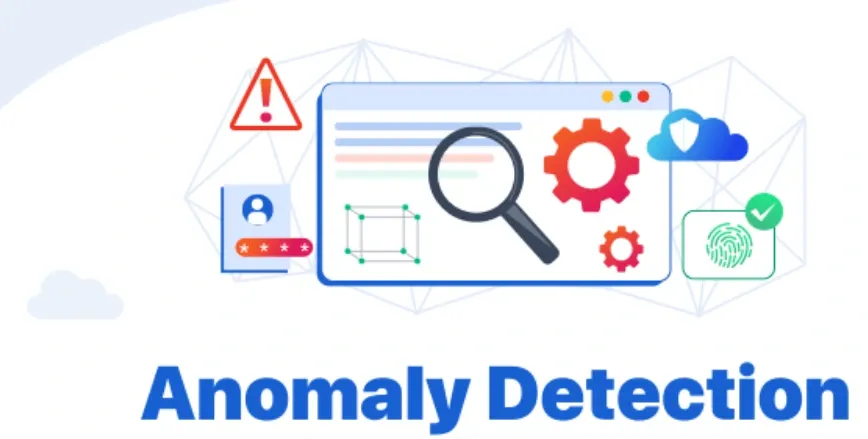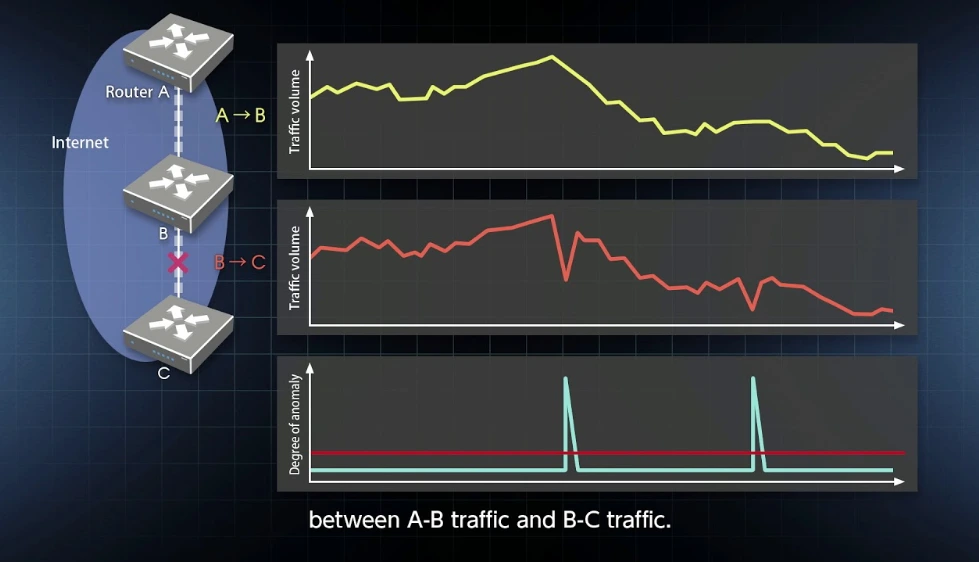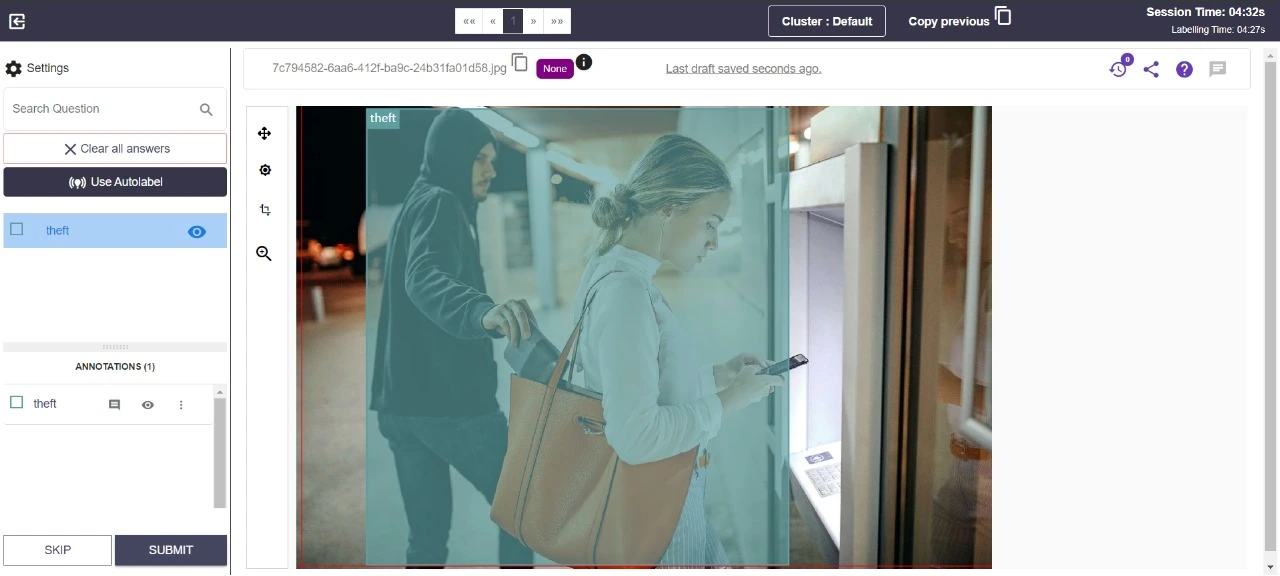Anomaly Detection For Video Based Security and Surveillance

Introduction
People want to make sure the world is super safe, just like how grown-ups make sure their homes are safe.
They wondered, "How can we find things that seem a bit different and might be a little tricky?" This is where something called Anomaly Detection comes in!
Anomaly Detection is like having smart eyes that can spot things not acting normally.
Anomaly Detection is like catching unusual change and telling us, "Hey, something suspicious is happening!"
In security, like when we want to keep important places safe, Anomaly Detection helps find strange things.
For example, it can notice if someone is acting in a way that's not usual, like staying near valuable things for too long.
Anomaly Detection can make things safer by reducing problems by almost 25%. That's like making sure 25 out of 100 tricky things are spotted before they become big problems. Isn't that amazing?
But, there's a challenge – it's tricky to teach computers to understand all the different kinds of tricky things that might happen. This is where Artificial Intelligence and Machine Learning come to help.
AI and ML models watch and learn what's normal from a lot of examples, just like we learn what's normal in our homes. When something unusual happens, they can quickly tell us, just like when you notice if your friend is acting a bit differently.
This blog meets the demands of efficiency-driven product managers, cutting-edge ML subject matter experts, and how Labellerr helps to create a large volume of training data necessary to build high performing ML model to make it possible.
Table of Contents
- What is Anomaly Detection?
- Use Cases of Anomaly Detection in Security and Surveillance
- Image-Level Anomaly Detection
- Pixel-Level Anomaly Detection
- Role of Deep Learning in Anomaly Detection
- Supervised vs Unsupervised Learning in Anomaly Detection
- Challenges and Future Directions
- Conclusion
- Frequently Asked Questions
What is Anomaly Detection?

The process of identifying observations, occurrences, or data points that differ from the norm, standard, or expected and are thus inconsistent with the remainder of the data set is known as anomaly detection, also known as outlier detection.
The history of anomaly identification in statistics dates back many years, when researchers and analysts would examine charts in search of any unusual characteristics.
These days, anomaly detection uses machine learning (ML) and artificial intelligence (AI) to automatically spot sudden variations in a data set's typical behaviour.
In security and surveillance, anomaly detection systems use machine learning algorithms and statistical techniques to establish a baseline of normal behavior within a given environment.
This baseline is created by analyzing historical data and learning the typical patterns and trends.
Once the baseline is established, the system continuously monitors incoming data and alerts security personnel when it identifies anomalies that deviate from the established norm.
Here are a few key points about anomaly detection in security and surveillance:
(i) Behavioral Anomalies
Anomaly detection can focus on behavioral anomalies, identifying patterns of behavior that differ significantly from the norm.
For example, unusual network traffic, login times, or user activities in a cybersecurity context.
(ii) Statistical Anomalies
This approach involves detecting anomalies based on statistical deviations from the norm.
Statistical models can identify outliers or abnormal patterns in data, signaling potential security issues.
(iii) Unsupervised Learning
Anomaly detection often employs unsupervised machine learning techniques, where the system learns from data without labeled examples of anomalies.
This makes it adaptable to evolving threats and changing environments.
(iv) Multimodal Anomaly Detection
In surveillance, anomaly detection may involve analyzing various data sources, such as video feeds, sensor data, and access logs, to provide a more comprehensive understanding of the environment.
(v) Real-time Monitoring
An effective anomaly detection system operates in real-time to provide timely alerts, allowing security personnel to respond quickly to potential threats.
(vi) Adaptability
Anomaly detection systems need to be adaptable to changes in the environment or system dynamics.
This adaptability ensures that the system can continue to accurately identify anomalies as the normal patterns evolve.
Use Cases of Anomaly Detection in Security and Surveillance

(i) Detecting Theft and Robbery
Theft and robbery are serious concerns in various settings, from retail stores to public spaces.
Anomaly detection in security cameras can be employed to identify suspicious behaviors, such as individuals loitering near high-value items or sudden, erratic movements.
A case study conducted in a retail environment demonstrated the effectiveness of anomaly detection in preventing theft.
The system alerted security personnel to unusual behavior, leading to timely intervention and the prevention of a potential robbery.
(ii) Addressing Assault and Violence
In crowded areas or public spaces, detecting and preventing assault is crucial for maintaining public safety.
Anomaly detection models can analyze video feeds to identify physical altercations or aggressive behavior, triggering immediate responses from security personnel.
Real-world examples highlight the success of implementing anomaly detection in identifying and preventing violent incidents.
This technology acts as an extra layer of security, enhancing traditional surveillance methods.
(iii) Mitigating Vandalism and Property Damage
Vandalism can cause significant financial losses and disrupt community life.
Anomaly detection systems can identify suspicious activities such as graffiti, property damage, or unauthorized access, allowing for quick response and intervention.
An urban case study demonstrated how anomaly detection in security cameras effectively reduced instances of vandalism.
By alerting authorities to unusual activities, the system contributed to a safer environment and a decrease in property damage.
(iv) Enhancing Arrest and Law Enforcement
Anomaly detection is not only about preventing crimes but also aiding law enforcement in their efforts.
By analyzing patterns of behavior, security systems can assist in identifying individuals with outstanding arrest warrants or known criminal histories.
A successful application of this approach was seen in a citywide surveillance system where anomaly detection helped law enforcement locate and apprehend individuals involved in criminal activities, significantly improving the overall safety of the community.
Image-Level Anomaly Detection
1. Density Estimation
(i) This approach involves creating a probability distribution model for normal images and establishing it as a reference for anomaly detection.
(ii) Challenges arise from the substantial requirement of training data and the complexity introduced by high-dimensional feature sets.
(iii) To address these challenges, researchers are exploring the use of deep generative models, such as variational autoencoders, as alternatives to traditional density methods like the Gaussian model or nearest neighbor.
2. One-Class Classification
(i) One-class classification constructs a decision boundary in the feature space, differentiating between normal and abnormal images.
(ii) Classic methods like one-class support vector machines have been employed, with recent developments focusing on hybrid models combining convolutional neural networks (CNNs) and support vector machines.
3. Image Reconstruction
(i) The image reconstruction approach involves mapping images to a low-dimensional vector in feature space, with small reconstruction errors indicating normalcy.
(ii) Auto encoders and generative adversarial networks are popular choices for image reconstruction-based anomaly detection.
(iii) Despite its effectiveness, this method may be less efficient in real-world applications due to the need for iterative search processes.
4. Self-Supervised Learning
(i) Leveraging models like RotateNet, self-supervised learning allows systems to learn essential features from given images autonomously.
(ii) These models excel in extracting both low and high-level features, providing a comprehensive understanding necessary for distinguishing between normal and abnormal images.
Pixel-Level Anomaly Detection
![]()
1. Image Reconstruction
(i) At the pixel level, anomaly detection assumes that models trained on normal images struggle to accurately reconstruct abnormal ones, leading to significant reconstruction errors.
(ii) L1 and L2 distance calculations serve as effective methods for detecting abnormalities at the pixel level.
(iii) The combination of variational auto encoders and generative adversarial networks shows promise in detecting anomalies, particularly in medical imaging.
2. Feature Modeling
(i) In this approach, anomalies are not detected in the image space but rather in the feature space.
(ii) Handcrafted feature extraction or convolutional neural networks can be employed to develop the feature space of normal images.
(iii) The challenge lies in the computational demand associated with processing an increased number of images and potential oversights in detecting anomalies in smaller sub-images.
Supervised vs. Unsupervised Learning

In the case of anomaly detection, unsupervised learning takes precedence due to its inherent robustness in dealing with the diverse and unpredictable nature of anomalies in real-world scenarios.
Supervised learning encounters difficulties in collecting a sufficiently diverse dataset of anomaly images, as anomalies can manifest in various shapes, sizes, and colors.
The Evolving Role of Deep Learning in Anomaly Detection

Deep learning's introduction has completely changed the approach to anomaly identification.
Convolutional neural networks (CNNs), in particular, are a type of deep neural network that has shown an impressive ability to extract complicated hierarchical information from photos.
Through the use of deep learning architectures, anomaly detection systems are able to autonomously identify complex patterns and anomalies without supervision.
Transfer learning has also gained popularity, allowing deep learning to be used in situations with little labelled anomaly data.
In transfer learning, massive datasets of pre-trained models are adjusted for particular anomaly detection tasks.
Challenges and Future Directions
Despite the advancements, anomaly detection in computer vision faces persistent challenges.
The scarcity of labeled data for anomalies, coupled with the diversity of anomalies in real-world scenarios, poses hurdles for supervised learning approaches.
Furthermore, ensuring the robustness of anomaly detection models to unforeseen anomalies and adapting to dynamic environments remains a research frontier.
Future directions in anomaly detection may involve the integration of multi-modal information, incorporating not just visual data but also other sensor inputs.
Explain ability and interpretability of anomaly detection models are becoming increasingly crucial, especially in applications such as security and surveillance, where understanding the reasoning behind a system's anomaly prediction is paramount.

How Labellerr Helps?

As the above picture illustrates, Labellerr excels at identifying theft scenarios or any anomalies in pictures.
Using its smart labeling engine, Labellerr has analyzed the image, accurately identified people and the scenario.
It has spotted that someone is attempting to steal, and then precisely created a bounding box around this suspicious activity.
Labellerr's foundation model based auto labeling capability helps it spot theft and other things going wrong really fast.
By harnessing the foundation model's deep learning capabilities, Labellerr ensures that its assessments are not only fast but also highly reliable.
Labellerr offers the flexibility of manual annotation for situations where higher accuracy is crucial.
This combination of automated efficiency and the option for manual refinement makes Labellerr a versatile and powerful platform.
Imagine you have lots of pictures and videos of places, like a school or a park. Labellerr helps you look at these pictures and videos to find anything unusual like someone stealing or breaking things.
Let's see in depth how it works:
(i) Connect Data
Labellerr can take all the pictures and videos you have, like from cameras in a store or a park, and put them in one place on the internet.
(ii) Make Projects
It helps you organize the pictures and videos into different projects. For example, one project could be about the school and another about the park.
(iii) Labeling Engine
Labellerr has a smart labeling engine. It can quickly look at pictures and videos and point out important things, like people or objects.
This helps a lot because you don't have to look at every single picture yourself.
(iv) Catch Problems Early
It can also find problems like stealing or breaking things by itself.
It's like having a smart friend who watches everything and tells you if something looks wrong.
(v) Easy to Understand
It can show the results in simple ways, like lists or pictures, so you can easily understand what's happening. If something doesn't look right, Labellerr will let you know.
Conclusion
A comprehensive comprehension of both image-level and pixel-level detection techniques is necessary for anomaly detection in computer vision, as it reveals a multidimensional and intricate field.
The secret to overcoming anomaly detection's hurdles as technology develops is to combine complex models with cutting-edge methods, opening the door to the creation of more reliable and effective computer vision systems.
In computer vision, anomaly detection is an ever-evolving discipline that benefits from a wide range of applications and rapid technology improvements.
The prospects for anomaly detection to make a substantial contribution to a range of industries and societal areas are still bright, provided that academics and practitioners can successfully manage the obstacles and discover new ground.
Frequently Asked Questions
1. Can deep learning be used in video anomaly detection?
Yes, deep learning can be effectively used in video anomaly detection.
Deep neural networks, particularly convolutional neural networks (CNNs) and recurrent neural networks (RNNs) excel at capturing complex temporal and spatial patterns in video data.
By training on normal behavior, these models can identify anomalies or unusual patterns in videos, making them valuable for applications such as surveillance, industrial monitoring, and anomaly detection in various domains.
2. What are the applications of anomaly detection techniques?
Anomaly detection techniques find applications across various domains, including cybersecurity, fraud detection, network monitoring, healthcare, and industrial operations.
In cybersecurity, anomaly detection helps identify unusual patterns indicative of malicious activities.
In fraud detection, it can uncover abnormal transactions or behavior. Network monitoring relies on anomaly detection to identify potential issues or security breaches.
In healthcare, it aids in identifying abnormal patient conditions, and in industrial operations, it can detect faults or irregularities in machinery.
Overall, anomaly detection techniques play a crucial role in identifying deviations from the norm in diverse fields, enabling proactive responses to potential threats or issues.
3. What is anomaly detection in datasets using computer vision?
Anomaly detection in datasets using computer vision involves the use of image analysis techniques to identify irregular or unexpected patterns within visual data.
Deep learning models, such as convolutional neural networks (CNNs), are commonly employed for this task.
These models are trained on normal patterns within the dataset and can subsequently detect anomalies or outliers that deviate from the learned normal behavior.
In applications like quality control in manufacturing, medical image analysis, or surveillance, computer vision-based anomaly detection proves valuable for identifying and flagging unusual visual patterns, contributing to enhanced decision-making and problem detection.
Book our demo with one of our product specialist
Book a Demo
